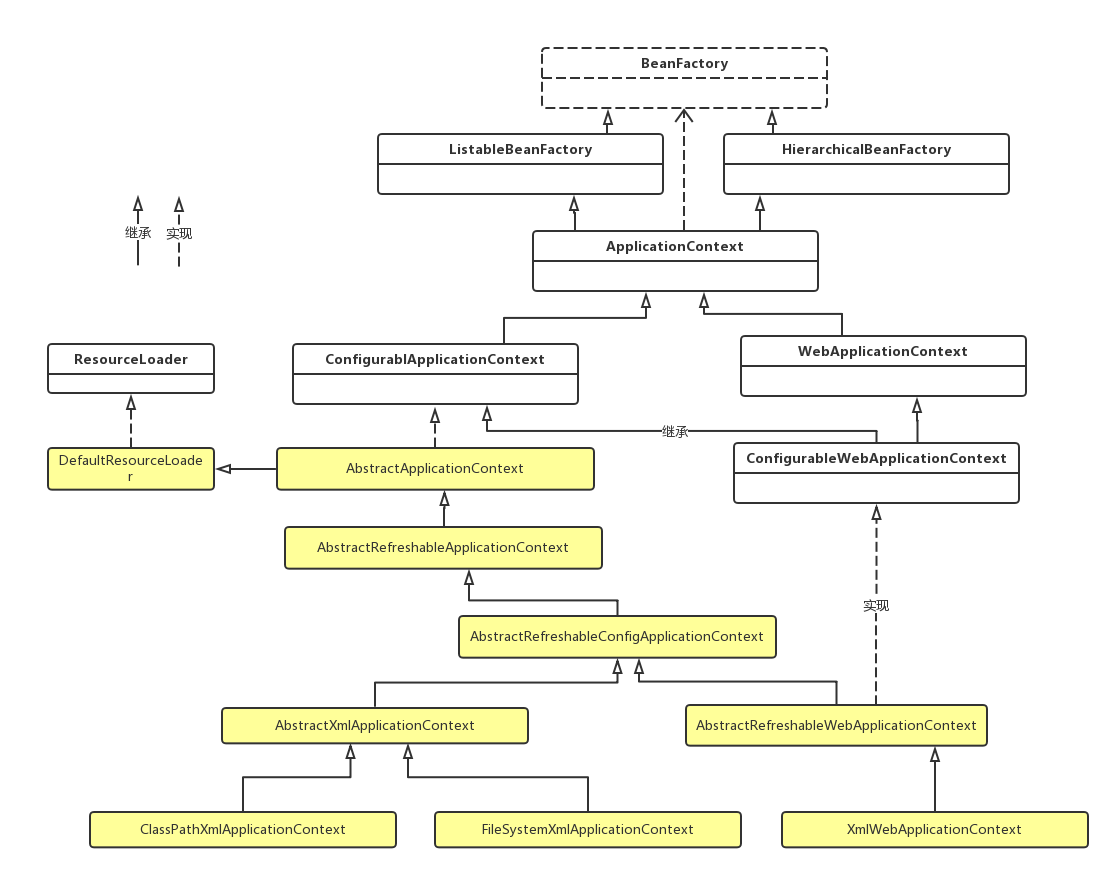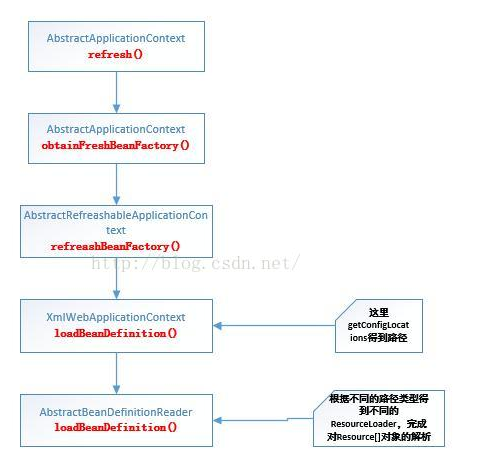前言
上一篇博文“ Spring IOC是怎样启动的 ”中提到了refresh()方法,这个就是容器初始化的入口。容器初始化共有三个阶段:
第一阶段:Resource定位
第二阶段:BeanDefinition解析
第三阶段:BeanDefinition注册
这一篇我们讲第一阶段Resource定位。
阅读目录
- 1.XmlWebApplicationContext的继承体系图
- 2.refresh()方法
- 3.Resource组件
1. XmlWebApplicationContext的继承体系图
我们知道Spring IOC容器的默认实现类是XmlWebApplicationContext,下图是ApplicationContext的继承体系,至于BeanFactory的分支,以后再研究

BeanFactory or ApplicationContext?
BeanFactory和ApplicationContext都是实现IoC容器的基础接口。Application是BeanFactory的子接口,包含了BeanFactory的功能,同时增加了对Transactions和AOP的支持。所以官方更推荐开发者使用ApplicationContext及其子类实现IoC容器。特别地,Spring在实现时,大量使用ApplicationContext实现BeanPostProcessor extension point。
2.refresh()方法
我们追溯XmlWebApplicationContext的refresh()方法,依据继承体系图,追踪源码至AbastractApplicationContext的refresh()方法。
refresh()是一个模板方法,执行多个方法,而且提供了各(protected)方法的(默认)实现,其子类可以重写它们
模板方法模式:在一个方法中定义一个算法的骨架,而将一些步骤延迟到子类中。模板方法使得子类(使用protected方法)可以在不改变算法结构的情况下,重新定义算法中的某些步骤。
refresh函数中调用了多个方法,这里先不详细讲解每一个方法,可以先通过英文注释大概了解各方法的作用。
AbastractApplicationContext的refresh()方法
@Override public void refresh() throws BeansException, IllegalStateException { synchronized (this.startupShutdownMonitor) { // Prepare this context for refreshing. prepareRefresh(); // Tell the subclass to refresh the internal bean factory.
//告诉子类启动refreshBeanFactory()方法,bean定义资源文件的载入从子类的refreshBeanFactory()方法启动【重点】
ConfigurableListableBeanFactory beanFactory = obtainFreshBeanFactory(); // Prepare the bean factory for use in this context. prepareBeanFactory(beanFactory); try { // Allows post-processing of the bean factory in context subclasses. postProcessBeanFactory(beanFactory); // Invoke factory processors registered as beans in the context. invokeBeanFactoryPostProcessors(beanFactory); // Register bean processors that intercept bean creation. registerBeanPostProcessors(beanFactory); // Initialize message source for this context. initMessageSource(); // Initialize event multicaster for this context. initApplicationEventMulticaster(); // Initialize other special beans in specific context subclasses. onRefresh(); // Check for listener beans and register them. registerListeners(); // Instantiate all remaining (non-lazy-init) singletons. finishBeanFactoryInitialization(beanFactory); // Last step: publish corresponding event. finishRefresh(); } catch (BeansException ex) { if (logger.isWarnEnabled()) { logger.warn("Exception encountered during context initialization - " + "cancelling refresh attempt: " + ex); } // Destroy already created singletons to avoid dangling resources. destroyBeans(); // Reset 'active' flag. cancelRefresh(ex); // Propagate exception to caller. throw ex; } finally { // Reset common introspection caches in Spring's core, since we // might not ever need metadata for singleton beans anymore... resetCommonCaches(); } } }
这个refresh()方法就是SpringIOC 容器的初始化全过程。那么我们先关注obtainFreshBeanFactory()这个方法,因为这个方法里面会实现我们上述的Resource定位及载入解析和注册。
2.1 obtainFreshBeanFactory()方法
obtainFreshBeanFactory()方法完成了容器初始化的最重要最基础的功能,Bean定义资源的Resource定位、载入解析和注册。
AbstractApplicationContext的obtainFreshBeanFactory()方法
protected ConfigurableListableBeanFactory obtainFreshBeanFactory() { refreshBeanFactory(); ConfigurableListableBeanFactory beanFactory = getBeanFactory(); if (logger.isDebugEnabled()) { logger.debug("Bean factory for " + getDisplayName() + ": " + beanFactory); } return beanFactory; }
protected abstract void refreshBeanFactory() throws BeansException, IllegalStateException;
public abstract ConfigurableListableBeanFactory getBeanFactory() throws IllegalStateException;
这里使用了委派设计模式,obtainFreshBeanFactory()中调用了两个抽象方法,定义了obtainFreshBeanFactory的算法骨架,实际的行为交给其子类(AbstractRefreshableApplicationContext)实现。
AbstractRefreshableApplicationContext的refreshBeanFactory()方法
@Override protected final void refreshBeanFactory() throws BeansException { if (hasBeanFactory()) { //如果已经有容器,销 毁 容器中的bean,关闭容器 以保证在refresh之后使用的是新建立起来的IoC容器 destroyBeans(); closeBeanFactory(); } try {
//创建IoC容器 DefaultListableBeanFactory beanFactory = createBeanFactory(); beanFactory.setSerializationId(getId()); //对IOC容器进行定制化,如设置启动参数,开启注解的自动装配等
customizeBeanFactory(beanFactory);
//调用载入Bean定义的方法,这里又使用了委派模式,在当前类中只定义了抽象的loadBeanDefinitions方法,具体的实现调用子类容器 loadBeanDefinitions(beanFactory); synchronized (this.beanFactoryMonitor) { this.beanFactory = beanFactory; } } catch (IOException ex) { throw new ApplicationContextException("I/O error parsing bean definition source for " + getDisplayName(), ex); } }
protected abstract void loadBeanDefinitions(DefaultListableBeanFactory beanFactory) throws BeansException, IOException;
由于是web容器启动的,追溯源码,我们看到XmlWebApplicationContext实现了loadBeanDefinitions()方法。
XmlWebApplicationContext的loadBeanDefinitions(DefaultListableBeanFactory beanFactory)方法
@Override protected void loadBeanDefinitions(DefaultListableBeanFactory beanFactory) throws BeansException, IOException { // Create a new XmlBeanDefinitionReader for the given BeanFactory. XmlBeanDefinitionReader beanDefinitionReader = new XmlBeanDefinitionReader(beanFactory); // Configure the bean definition reader with this context's // resource loading environment. beanDefinitionReader.setEnvironment(getEnvironment()); beanDefinitionReader.setResourceLoader(this); beanDefinitionReader.setEntityResolver(new ResourceEntityResolver(this)); // Allow a subclass to provide custom initialization of the reader, // then proceed with actually loading the bean definitions. initBeanDefinitionReader(beanDefinitionReader); loadBeanDefinitions(beanDefinitionReader); }
上面的XMLBeanDefinitionReader我们先不理睬,后面BeanDefinition解析的时候会讲到这个类,我们直接看loadBeanDefinitions方法,这里是具体载入bean信息,那么要载入就要知道bean的定义文件在哪,所以Resource定位还要继续跟下去,来看这个方法的源码:
XmlWebApplicationContext的loadBeanDefinitions(XmlBeanDefinitionReader reader)方法
protected void loadBeanDefinitions(XmlBeanDefinitionReader reader) throws IOException {
//获取ConfigLocations,也就是配置文件路径 String[] configLocations = getConfigLocations(); if (configLocations != null) { for (String configLocation : configLocations) { reader.loadBeanDefinitions(configLocation); } } }
看到这里大家还记得之前我们的web.xml里面配置的context-param吗?还记得我们的ContextLoader里面设置了wac.setConfigLocation(sc.getInitParameter(CONFIG_LOCATION_PARAM))吗?这里我们就取到了xml的位置。但是这里我们并没有看到我们一直在说的Resource,那么继续看代码:经过了一次重载的方法,我们最终可以看到这个方法:
AbstractBeanDefinitionReader的loadBeanDefinitions方法
public int loadBeanDefinitions(String location, Set<Resource> actualResources) throws BeanDefinitionStoreException {
//这里得到当前定义的ResourceLoader,默认的使用DefaultResourceLoader ResourceLoader resourceLoader = getResourceLoader(); if (resourceLoader == null) { throw new BeanDefinitionStoreException( "Cannot import bean definitions from location [" + location + "]: no ResourceLoader available"); } //下面这堆是对Resource的路径模式进行解析(像我们在web.xml里面有可能使用通配符等),得到需要的Resource集合,这些Resource集合指向了我们定义好的BeanDefinition的信息,可以是多个文件。 if (resourceLoader instanceof ResourcePatternResolver) { try {
//将指定位置的Bean定义资源文件解析为Spring IoC容器封装的资源(Resource) Resource[] resources = ((ResourcePatternResolver) resourceLoader).getResources(location); int loadCount = loadBeanDefinitions(resources); if (actualResources != null) { for (Resource resource : resources) { actualResources.add(resource); } } if (logger.isDebugEnabled()) { logger.debug("Loaded " + loadCount + " bean definitions from location pattern [" + location + "]"); } return loadCount; } catch (IOException ex) { throw new BeanDefinitionStoreException( "Could not resolve bean definition resource pattern [" + location + "]", ex); } } else { // Can only load single resources by absolute URL. 这里通过ResourceLoader来完成位置定位 Resource resource = resourceLoader.getResource(location); int loadCount = loadBeanDefinitions(resource); if (actualResources != null) { actualResources.add(resource); } if (logger.isDebugEnabled()) { logger.debug("Loaded " + loadCount + " bean definitions from location [" + location + "]"); } return loadCount; } }
那么对于取得Resource的具体过程,((ResourcePatternResolver) resourceLoader).getResources(location)这个方法大家点开看看就可以知道,是PathMatchingResourcePatternResolver中的实现的,它具体里面就是针对我们配置的是否以“classpath*:” 开头分别处理。对于resourceLoader.getResource(location)方法,具体是交给继承ResourceLoader的子类完成的。这里不再多述了。
总结一下,容器初始化各个父类方法调用,不然就更懵了!

3.Resource组件
Resource组件与ResourceLoader组件一起工作,将字符串格式指示的资源解析为Resource对象。事实上ResourceLoader是Resource的工厂类, ResourceLoader的核心工作就是解析location。
location示例:”classpath:applicationContext.xml”,”classpath:applicationContext-.xml”,”file:/some/resource/path/myTemplate.txt”,"http://XX/resource/path/myTemplate.txt“ ResourceLoader根据所指示的前缀返回特定的Resource对象。看下Resource的结构图:
